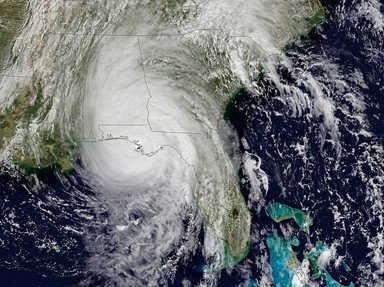Quiz Answer Key and Fun Facts
1. Back in 1935, hurricanes didn't have assigned names. The first Saffir-Simpson Category 5 to strike the USA mainland had to be called something, so they named it after the holiday it obliterated in the Florida Keys. What is it still called?
2. In 2019, Hurricane Dorian and its 175 mile/280 kilometer per hour winds had Florida holding its breath for two days. Florida got lucky, some of our island neighbors did not. The Category 5 beast stalled over one island for a full day. Do you know which island?
3. Hurricanes in the western Pacific Ocean are called typhoons. Typhoon Haiyan in 2013 was called Typhoon Yolanda in the country it hit the hardest. In that nation well over 6000 people were killed by 195 mile per hour/312 kilometer per hour winds, huge storm surges and rain induced mudslides. Entire villages in Leyte and Samar were destroyed. What country was Yolanda's victim?
4. Before hurricanes were assigned names, parts of the Caribbean traditionally used the name of the saint whose feast day the storm arrived on. Sometimes, a date and name did double duty, like the feast of St Philip on 13 September. Huracan San Felipe Segundo (II) arrived in 1928, and as of May 2024 remains the only Category 5 to strike the island that both San Felipes hit. Can you pick the island from the list?
5. In 1969, the only Saffir-Simpson Category 5 hurricane to strike the USA mainland outside of Florida, howled ashore in Mississippi with winds of 175 miles/280 kilometers per hour. Ironically, this blowhard shared its name with the tubercular heroine of a 1936 film starring Greta Garbo! Can you name the hurricane/movie?
6. In the Indian Ocean, a hurricane is called by the rather generic term of cyclone. The term may be generic, but the storms are not, often ranking among the deadliest tropical systems. In May 2023, the evacuation of almost three-quarters of a million people in Bangladesh and Myanmar kept the death toll down in a cyclone that sounded like it came from Starbucks. The storm was more bitter than the flavored coffee it shared a name with. Can you select the name?
7. As I write (May 2024), the most recent Saffir-Simpson Category 5 hurricane to strike the US mainland nearly deleted the town of Mexico Beach, Florida, from the map. Despite 160 mile/255 kilometer per hour winds and storm surges that caused $20 billion in damages, fewer than 50 people lost their lives. Perhaps the Florida panhandle has a guardian angel. This devil of a hurricane carried an angel's name, to boot. Can you guess which angel?
8. Saffir-Simpson Category 5 hurricanes can occur in the eastern Pacific Ocean, too. In 2023, a tiny, feeble looking tropical storm named Otis suddenly turned into a tiny, but vicious monster. It smacked a famous Mexican resort city in the state of Guerrero with winds approaching 160 miles/256; kilometers per hour. Can you identify the resort that endured Otis?
9. Called SuperTyphoon Polly in the Philippines was known by another name on the Asian mainland. While nothing is funny about a storm with 190 mile/315 kilometer per hour winds, the odd mindset of a Floridian talking hurricanes takes hold, and suggests that the storm's story could be headlined by tying its other name to Margaret Mitchell's Civil War novel. What would the title be?
10. You know a hurricane is something special when it makes the National Hurricane Center move to a new location! The 1992 Hurricane Season got off to a terrifying start when the first named storm became a Category 5 hurricane with winds of 160 miles/256 kilometers per hour. What was the name of the hurricane that ran the National Hurricane Center out of Coral Gables, and nearly leveled Homestead, Florida?
Source: Author
Jdeanflpa
This quiz was reviewed by FunTrivia editor
ponycargirl before going online.
Any errors found in FunTrivia content are routinely corrected through our feedback system.
